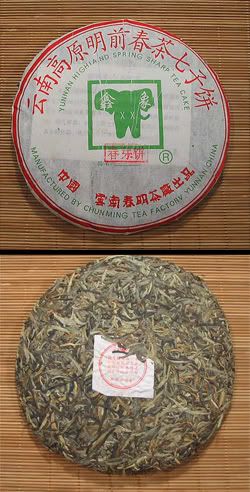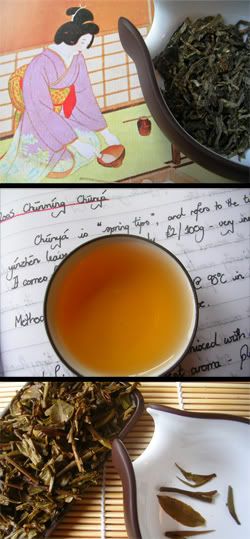To that end, we would very much like to take advantage of the "poll" functionality offered by the web-site to see how well matched the site's content is to most readers' interests. If I could trouble you to briefly cast your eyes over the poll to the upper-left of this page, I'd be very grateful for your feed-back.
 The Chunming [spring bright] factory has been in operation since 2000, and we previously encountered their products in the 2005 Chunming Nuomixiang [glutinous rice scent] shupu, which was rather pleasant - if unorthodox for obvious reasons.
The Chunming [spring bright] factory has been in operation since 2000, and we previously encountered their products in the 2005 Chunming Nuomixiang [glutinous rice scent] shupu, which was rather pleasant - if unorthodox for obvious reasons. Chunming Factory forever lives on in folklore as the company that has an elephant's derriere for its logo...
This chunya [spring tips] bing looks rather similar to a yinzhen [silver needle] pu'er cake, being made of small, silver tips. Thanks to VL for this sample, the original bing sells for an entirely inexpensive £2 [$4] from Royal Pu'er.
Brita-filtered water @ 95C in 12cl shengpu pot; ~8-9g leaf; 1 rinse
Dry leaf:
Small, spring tips mixed with other small, dark leaves. There is a sweet aroma about the sample which is most pleasant.
4s, 6s, 7s, 12s, 18s, 21s, 25s, 32s, 36s:
"Forewarned is forearmed", and the vendor's web-site lists comments from previous buyers describing how using more leaf provides better results - hence the big pile of leaves in the chahe for this session [pictured].
 From the infusion times, you might assume that the tea has some strength and endurance to offer, and you would be correct to do so!
From the infusion times, you might assume that the tea has some strength and endurance to offer, and you would be correct to do so!The soup is amber-gold, with a gently sweet aroma about it. The flavour is actually rather pleasing, consisting of a basis of mushrooms with overtones reminiscent of a decent baicha. There is a touch of dianhong about the entire affair, perhaps imparted by the dark, oxidised mixture-leaves.
"This is very tender; we should get some." The huigan is light, and the flavour has a certain smoothness - not the extravagantly luxurious smooth texture of some yinzhen cakes, but certainly appealing.
Later infusions show its roots as a young shengpu, and a touch of greenness begins to show through - though this tea never cracks with later infusions, rather tending towards a straw-like simplicity. It is constant and simple.
Wet leaves:
Generally decent: as noted previously, it is a tippy grade mixed with a low-grade stem-and-fragment set of leaves.
Overall:
Perhaps, like the 2006 Yibang Chamasi, this is a quiet surprise: it is decent, enduring, and doesn't crack under pressure.
It responds well to using very large quantities of leaf, and our experience lends itself to recommending that one shouldn't be too conservative with the brewing times. It is a simple mixture of creamy tippiness atop a basis of fair pu'er flavours. It won't change your world, but for the almost negligible price, it's hard to find fault with this simple yet pleasant little fellow.
Don't buy it to age, but it might prove an interesting diversion within its class. I shudder with terror to think what tea £2 would buy me in an English supermarket.
Update:
Following a second sample of biluochun sent by TeaCuppa, I have added some addenda to the previous 2007 Biluochun notes.

2 comments:
Well, the beeng does not sell for $4, they're only selling 100g loose leaf... and it's out of stock too! I guess they ran out.
I think this tastes more like red tea than Pu-erh or even white tea...
-vl.
I remember trying some Chunming stuff before in one of my trips to Maliandao. Nothing too exciting, I must say.
Post a Comment